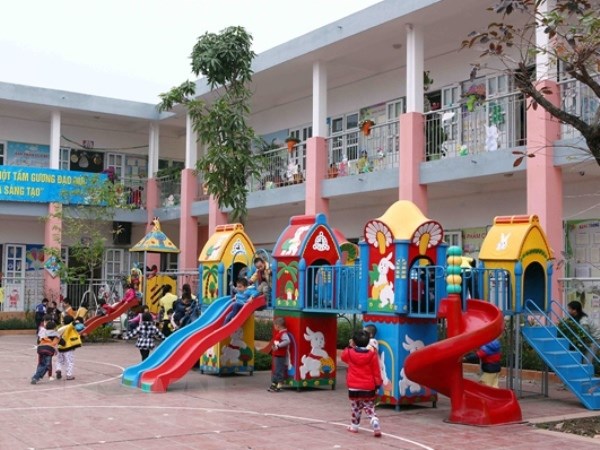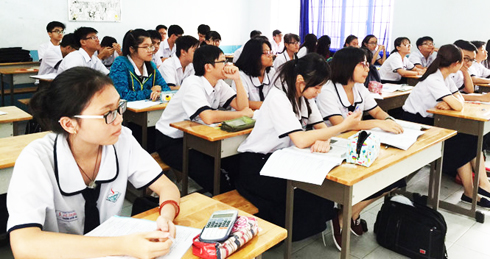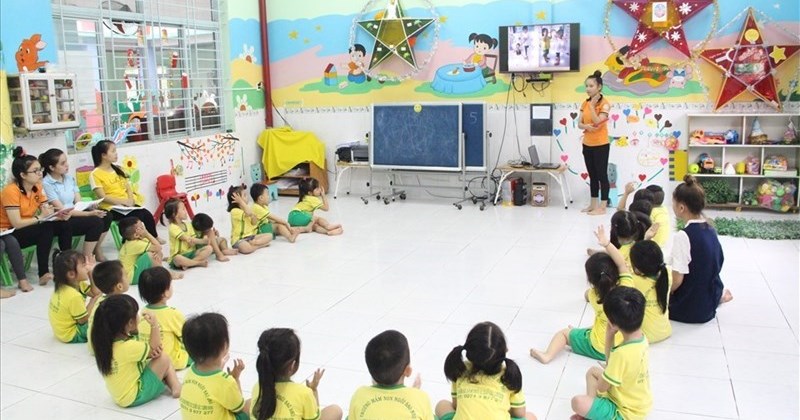What are the regulations on process of the preschool self-assessment in Vietnam? - Ngoc Minh (HCMC)

Process of the preschool self-assessment in Vietnam (Internet image)
Process of the preschool self-assessment in Vietnam
In Article 23 of Circular 19/2018/TT-BGDDT. The preschool self-assessment process includes the following steps:
Step 1: Establish a self-assessment board.
Step 2: Plan a self-assessment.
Step 3: Collect, process and analyze the evidence.
Step 4: Evaluate the levels achieved according to each criterion.
Step 5: Write a self-assessment report.
Step 6: Publish the self-assessment report.
Step 7: Deploy activities after completing the self-assessment report.
07 steps of preschool self-assessment
The 07 steps of self-assessment for preschools are specified in Official Dispatch 5942/BGDDT-QLCL in 2018 guiding self-assessment and assessment outside preschool as follows:
Step 1: Set up a self-assessment committee.
- The principal of the kindergarten shall issue a decision to establish the Self-Assessment Council.
- The number of members and members participating in the SA Council as prescribed in Article 24 of Circular 19/2018/TT-BGDDT.
- Tasks and powers of the SA Council are specified in Article 25 of Circular 19/2018/TT-BGDDT.
Step 2: Plan a self-assessment.
The SA plan is developed by the SA Council and has contents according to Appendix 1. The President of the SA Council approves the SA plan.
The SA plan is suitable for the actual conditions of the school; it is necessary to clearly define the specific tasks of the members of the SA Council, the secretariat, the working groups, and each individual. The SA plan should clearly state the content of each activity, implementation time, completion time, general avoidance, and form.
During the implementation of the SA Plan, if any inappropriate issues arise, they can be adjusted and supplemented.
Step 3: Collect, process, and analyze the evidence.
- Proof concept
Evidence is understood as documents, records, books, tapes, video discs, and other existing objects of the school that are consistent with the content of the indicator and criteria.
Evidence is used to support the statements and conclusions in the section "Description of the current situation" for each criterion of the SA report.
Evidence is collected from the archives of the school and relevant agencies;
Results of a survey, investigation, interview, and observation of child rearing, care, and education activities in preschool.
Evidence must have a clear origin and be accurate.
The evidence obtained is not only used for the purpose of assessing the achievement levels of each indicator and criterion, but also to describe the current status of the school's activities for readers to better understand; thereby increasing the persuasiveness of the SA report.
- Determine the content, analyze the criteria to find evidence.
To determine the correct and sufficient content (requirements) of each indicator, the following criteria should be noted:
(1) Indicators and criteria often have important words and phrases that mean "keywords";
(2) Each indicator or criterion has one or more connotations;
(3) It is necessary to determine the content of each indicator, the criteria according to the provisions of an education quality accreditation cycle, and the time limit for the recognition of national standards;
(4) Compare the school's "specific goals" related to the content of indicators and criteria.
On the basis of having correctly and sufficiently determined the contents of indicators and criteria, the working group or individual will analyze the criteria to find the evidence to collect, where to collect it and record it in the Content Determination Form, and analyze the criteria to find evidence of the criteria (refer to Appendices 2 and 3) .
To assess the actual status of each content of the indicator or criterion, the school can ask and answer (corresponding to the content) questions such as:
+ Does the school have a plan to implement the request?
+ Has the school implemented and met the requirements?
+ How are the requirements achieved by the school compared to the general requirements?
+ How does it compare with other schools with similar conditions (economic - social, cultural,...)?
+ How did the school "go beyond" the requirements?
+ How does the school review and check the implementation of the requirements?
+ Evidence to confirm that the school has a plan, implements the request, reviews and checks the implementation of the request, ...
Answering the above questions, the school analyzed the criteria, oriented the collection of evidence, and prepared for the next steps of the SA process.
- Collect evidence.
Based on the forms to determine the content and analyze the criteria to find evidence of the criteria, the working group or individual is assigned to collect evidence and arrange evidence in order of content of indicators and criteria of preschool assessment standards.
In the event that no evidence can be found for a certain indicator or criterion (fire, natural disaster, no records in previous years,...), the SA Council clearly states the reason in the Criteria Assessment Sheet.
- Processing and analyzing evidence
The SA panel discusses the evidence for each criterion that has been collected by the working group or the individual. When proofs are used, the SA Council prepares a list of proof codes (refer to Appendix 4).
In fact, there are proofs that can be used immediately as proofs, but there are also proofs that must be processed, analyzed, and synthesized before they can be used to prove the statements and conclusions in the section "Description of the status quo".
For example, most of the evidence obtained from the results of surveys, interviews, and observations on the child rearing, care, and education activities of preschools must be processed into a form of aggregated data that can be used as evidence in the "Description of the current situation" section.
The proofs that are consistent with the content of indicators and criteria will be used in the "Description of the current status" section of the Criteria Assessment Sheet.
These proofs, before being used, need to be encrypted for the purpose of being concise and easy to look up.
The proof code can be denoted by a string consisting of 1 letter (H), two dashes (-) and conventional digits: [Hn-a.b-c].
In which, H is the box (pair) containing the evidence; n is the ordinal number of the box (pair) containing the proof numbered from 1 to the end (n can have 2 digits); a.b is the symbol of the criterion in each standard (Example: Criterion 1.1, Criterion 1.2,...; Criterion 2.1, Criterion 2.2,...); c is the ordinal number of the proof according to each criterion (first proof write 01, second write 02, 15th write 15).
For example:
[H1-1.1-01] is understood as the first demonstration of criterion 1.1 of criterion 1, which is placed in box 1;
[H3-2.1-03] is understood as the third proof of criterion 2.1 of criterion 2, placed in box 3;
[H9- 5.1-01] is understood as the first demonstration of criterion 5.1 of standard 5, which is placed in box 9.
The proof code used for the criteria at Level 4 should be denoted as follows: [Hn-M4-a-b].
In which, H is the box (pair) containing the evidence; n is the ordinal number of the box (pair) containing the proof, numbered from 1 to the end (n can have 2 digits); M4 is Level 4; a is the ordinal number of the criterion (From criterion 1 to criterion 6); b is the ordinal number of the proof according to each criterion (first proof write 01, second write 02, 15th write 15).
For example, [H6-M4-01-01] is the first instance of criterion 1 of Level 4, placed in box 6.
For proofs used at Level 4, which have been encrypted and used in the criteria of Level 1, Level 2 or Level 3, only the proof code needs to be quoted (keep the same proof coding used).
In the event that the school does not keep the proofs separately in the boxes (pairs) but still keeps them in the school's archives, the proof code will be denoted as [a.b-c].
In this case, the specific location (link) of the proof placed in the school's archives must be specified in the list of proof codes.
- Use evidence.
Each certificate is encrypted only once. The proof used for more than one criterion in a standard or multiple standards carries the proof code of the criterion used for the first time.
Each statement and conclusion in the "Description of the current situation" section of the Criteria Assessment Sheet (which is then used in the SA report) must be accompanied by evidence. It is necessary to select one or several proofs suitable for the content of the indicator, criteria and write the coded symbol after each statement or conclusion.
In case a statement or conclusion in the section "Description of the status quo" has two or more proofs, the proof codes are placed next to each other, separated by a semicolon (;).
Example: A statement, conclusion, of Criterion 2.1 of Standard 2 with 3 evidences, first, second, and third (placed in box 3) is used, and after that statement, conclusion, the proofs are written as: [H3-2.1-1]; [H3-2.1-02]; [H3-2.1-03],
Only one copy is required for each demonstration (including those used for multiple indicators, criteria, and standards), do not duplicate to avoid waste.
- Storage and preservation
Evidence can be collected and arranged in boxes (pairs) in order of encryption. Evidence that has expired is replaced by evidence that is still valid and relevant. The replacement proof shall be marked with the symbol of the replaced proof and clearly state the replacement date, month, and year.
Note, that evidence serving the management of child rearing, care, and education activities should be archived and preserved in the school's archives, but the list of proof codes must specify the specific location (path) of the proof for convenience in looking up and searching.
For complicated and cumbersome proofs (artifacts; systems of records and books, documents, materials with a large number of pages, etc.), schools can make tables, summary tables, statistics of data, and figures for convenience of use.
If possible, take a digital photo for proof, save it on a CD, USB drive, or computer.
Evidences shall be archived and preserved in accordance with the Law on Archives and current regulations.
Step 4: Evaluate the achieved levels according to each criterion.
- The evaluation of levels achieved according to each criterion is done through the Criteria Assessment Sheet.
For criteria belonging to Levels 1, 2, and 3 in the evaluation standard, depending on the content of the indicator, the criterion "Description of the current situation" in the Criteria Assessment Sheet can be implemented according to Appendix 5 a or 5 b. Criteria under Level 4 in the evaluation criteria, then write the Criteria Assessment Sheet according to Appendix 5b.
- Criteria assessment sheet includes the following contents:
Describe the status quo, strengths, weaknesses, quality improvement plans, and self-assessment. Criteria assessment sheets are written by working groups or individuals and must be consulted by the SA Council. Each criterion is evaluated according to a Criteria Assessment Sheet.
- The process of writing and completing the Criteria Evaluation Form is carried out as follows:
+ Step 1: The working group or individual researches and analyzes the content of the criteria, indicators, and evidence used to write the contents as prescribed in the Criteria Assessment Sheet;
+ Step 2: The working group discusses the contents of the Criteria Assessment Sheet for correction and supplementation;
+ Step 3: The SA Council discusses the contents of each Criteria Assessment Sheet.
In particular, special attention is paid to the quality improvement plan for each criterion to clearly define measures, solutions, conditions (human, financial), implementation time, completion time, and that it must be feasible;
+ Step 4: Based on the SA Council's opinion, the working group or individual completes the Criteria Assessment Form and sends it to the SA Council secretary.
- The assessment levels for preschools are as prescribed in Article 6 of Circular 19/2018/TT-BGDDT. The results of each criterion are summarized in the Summary of the SA Results (refer to Appendix 6).
Step 5: Write a self-assessment report.
- The SA report is a document that reflects the current status of the school's quality, the school's commitment to quality improvement activities.
The SA results are presented in the form of a report with the structure and format specified in this guideline (refer to Appendix 6).
- The SA report should be concise, clear, accurate, and full of contents related to all criteria. The SA report is presented in order of criteria.
For each criterion, there should be enough items: a description of the current situation, strengths and weaknesses, a quality improvement plan, and a self-assessment.
The contents presented in the Criteria Assessment Sheets approved by the SA Council will be included in the SA report.
- The SA report meets the requirements when:
Presented in the form and structure of this manual;
No spelling or grammatical errors;
There is no conflict between the contents of a criterion and the criteria;
The proofs must be sufficient, clear, and convincing;
There is sufficient evidence to confirm the achievement of indicators and criteria;
Properly assess the status of the school;
The item "Description of the current situation" must be correct and full of content;
Correctly identify strengths and weaknesses according to each criterion;
The quality improvement plan for each criterion must be appropriate and feasible;
The level of achievement of the criteria proposed by the school is satisfactory.
- The draft SA report must be forwarded to working groups and individuals providing evidence to verify the evidence used and the accuracy of the statements and conclusions drawn therefrom. Working groups and individuals are responsible for reviewing the report content related to the assigned criteria.
- The final draft of the SA report is published to collect comments from officials, teachers, and staff at the school.
The SA Council studies, receives comments and suggestions to complete the report, and signs and confirms the SA report after reading and agreeing with the content of the SA report.
- After the SA report is unanimously approved by the SA Council, the principal considers it, signs it, and seals it.
The original SA report (can be 02 copies) is kept at the school and sent to the competent authority for reporting or registration for external assessment (if eligible to register for external assessment).
A copy of the SA report is kept in the library, traditional room, or in the school's file cabinet; The SA report is allowed to be borrowed and used according to the regulations of the principal.
Step 6: Publish the self-assessment report
The completed SA report will be published by the school within the school. It is encouraged to publish the SA results of the SA report (pdf file) on the school's website.
Step 7: Implement activities after completing the self-assessment report.
- Implementing the quality improvement plan set out in the SA report to improve the quality of the school's child rearing, care, and education activities;
- Sending the SA report to the direct management agency, enclosed with a written request for interest and support in the process of improving quality according to the quality improvement plan stated in the SA report;
- Every year, the SA report is updated (in the form of an additional report) and stored at the school;
- The school fulfills its responsibilities as prescribed in Article 43 of Circular 19/2018/TT-BGDDT.
- Key word:
- preschool
- in Vietnam
 Article table of contents
Article table of contents










.Medium.png)
.Medium.png)
.Medium.png)
.Medium.png)
